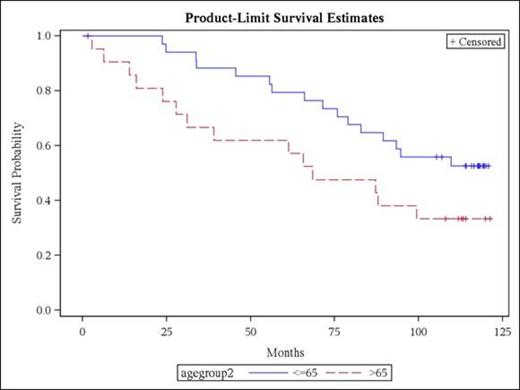Abstract
There is no single accepted treatment approach for mantle cell lymphoma (MCL), varying from intensive therapy in young, fit patients (pts) to less intensive for the more common older or less fit pts. R-CHOP remains a commonly used initial therapy for MCL, yielding high response rates but with limited durability, and still serves as a comparator in recently published studies. E1499 was designed to test the hypothesis that 1 dose of radioimmunotherapy (RIT) consolidation with 90Y-ibritumomab tiuxetan after only 4 cycles of R-CHOP-21 as initial therapy for MCL would be safe, well-tolerated and improve time-to-treatment failure (TTF) compared with historical R-CHOP data. E1499 met its primary endpoint with TTF at 1.5 years of 69% (95% CI 58-78%) (Smith et al JCO 2012) and treatment was well-tolerated. Here we report 10 year follow-up data on this uniformly-treated cohort of pts with MCL.
56 eligible pts with previously untreated MCL and adequate organ function were enrolled between 11/03-2/05. Median age at enrollment was 60 (range 33-83) yrs, 73% were male and MIPI was low in 50%, intermediate in 27% and high in 21%. All cases were centrally reviewed. Therapy was standard dose R-CHOP given every 3 weeks for only 4 cycles, followed in pts whose disease did not progress with a single standard administration of 90Y-ibritumomab tiuxetan. All planned therapy was administered to 91% (5 did not receive RIT: 3 PD, 1 death from MI, 1 pt preference). The overall response rate after all treatment was 82% (55% CR/CRu). Median follow-up is now 9.8 years (May 2015 data cut-off). Median TTF is 34 months (mos). By MIPI, TTF was 36 mos for low, 25 mos for intermediate and 10 mos for the 12 pts with high MIPI. Pts who achieved CR had median TTF of 38 mos vs 15 mos for PR (p = 0.01).
Median overall survival (OS) for the 56 eligible pts is 7.9 yrs. For pts < 65 median OS has not been reached at 10 yrs, compared with 7 yrs for those ≥ 65 (p = 0.07). OS for low MIPI pts also has not been reached at 10 yr, is 8 yr for intermediate and 5.5 yrs for high MIPI. Although TTF was longer for pts with CR/CRu, OS did not differ. There has been no additional therapy-related myeloid neoplasia (t-MN) other than 1 previously reported t-MN which occurred after additional therapy. Other malignancies include 2 non-small cell lung cancers, 1 bladder cancer, 1 ampullary adenocarcinoma and 2 resected localized non-melanoma skin cancers.
Long-term follow-up of this cohort of pts treated with a simple 4 month outpatient regimen continues to suggest a benefit for RIT consolidation in prolonging TTF, with median TTF of almost 3 yrs. Though in somewhat older populations, median PFS was 14 mos for 6xR-CHOP alone and 25 mos for 6xVR-CAP (Robak T NEJM 2015), and 22 mos for 6xR-CHOP in StiL trial (Rummel M Lancet 2013). Ongoing rituximab maintenance after 8xR-CHOP is also effective (Kluin-Nelemans NEJM 2015) with 57% of pts progression-free at 4 yrs. For OS, age is the single most important prognostic factor in this cohort. Pts with high MIPI had short TTF, but their OS suggests that additional therapies were effective. As novel agents rapidly move into first-line regimens, often based on early assessments of efficacy, these long-term data inform benchmark expectations of PFS and OS in MCL. OS in our cohort is comparable to contemporaneous studies using either intense or non-intense initial therapy, raising questions regarding the value of intensive treatment strategies in MCL.
Smith:celegene, spectrum, genentech: Honoraria. Off Label Use: Y90-ibritumomab tiuxetan is not approved for use in mantle cell lymphoma. Gordon:Dr Leo I. Gordon: Patents & Royalties: Patent for gold nanoparticles pending; Northwestern University: Employment. Horning:Genentech: Employment.
Author notes
Asterisk with author names denotes non-ASH members.


This feature is available to Subscribers Only
Sign In or Create an Account Close Modal